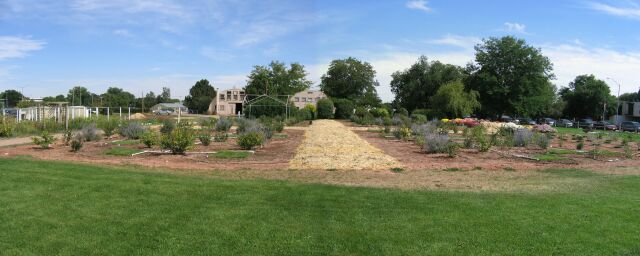
Throughout much of Colorado, the demand for water increases while the available water supply decreases. As a result, it is increasingly more important to conserve water wherever possible. One way to conserve water is to plant low water use shrubs in the urban landscape. Unfortunately, little scientific research has been conducted on determining the water use of common plant species that are used in urban landscapes and distributed throughout nurseries and garden centers in the Rocky Mountain region. Most plant species’ responses to limited irrigation are based solely upon opinion or visual observation, and as a result, a shrub water use study was conducted during the 2010 growing season at the W.D. Holly Plant Environmental Research Center at the Fort Collins Colorado State University campus (Figure 1). The purpose of the study was to determine the growth response of four shrub species that are commonly marketed throughout Colorado nurseries and garden centers for planting in Colorado landscapes. The shrubs were subjected to progressively decreased amounts of irrigation based on the evapotranspiration (ET) of a short reference crop, and the resulting responses were assessed. The species that were tested were: Cornus sericea (redosier dogwood) (Figure 2), Hydrangea arborescens ‘Annabelle’ (Annabelle hydrangea), Physocarpus opulifolius ‘Monlo’ (Diablo® ninebark), and Salix pupurea (arctic blue willow); one cool-season grass was used as a control: Poa pratensis (Kentucky bluegrass.)
The experiment consisted of two separate components. The first was an in-field component in which the shrubs and turf were planted in the ground. This in-field component tested all four species of shrubs and the turf using four separate treatments (0%, 25%, 50%, and 100% of ET of a short reference crop). The second part of the experiment was a lysimeter component, in which two of the species were grown in a pot-in-pot system and received 25%, 50%, or 100% of ET. Only the redosier dogwood and Annabelle hydrangea were tested in the lysimeter component due to space limitations. All plants (in both components) were planted during the 2008 growing season and were provided with 100% ET so that the shrubs could establish. In 2009 and 2010, irrigation treatments were implemented weekly, and the average amounts provided during 2010 are depicted in Table 1. Data collection included plant heights and widths, predawn leaf water potentials, daily water use (using the plants grown in the lysimeter component only), visual ratings, infrared temperatures (turf only), end of season sample leaf area, end of season sample leaf fresh and dry weights, and end of season whole above ground plant fresh and dry weights.
| 0% | 25% | 50% | 100% | |
|---|---|---|---|---|
| In Field Trials (5/17/10 – 10/5/10) | 0 | 0.63 | 1.23 | 2.48 |
| Lysimeter Trials (5/17/10 – 5/24/10)* | N/A | 0.27 | 0.54 | 1.09 |
| Lysimeter Trials (5/25/10 – 7/8/10)** | N/A | 1.01 | 2.01 | 4.03 |
| Lysimeter Trials (7/9/10 – 10/5/10 )** | N/A | 2.58 | 5.16 | 10.33 |
*watering amounts calculated using estimated rooting area
**watering amounts calculated using estimated leaf area
The Kentucky bluegrass in the in-field component responded as expected when irrigation amounts decreased, however, the shrubs did not follow such a predictable pattern. As irrigation amounts decreased for the Kentucky bluegrass, surface temperatures of the turf increased and overall visual appeal decreased. Interestingly the tested shrubs responded much differently than the control. The tested shrubs resulted that all species had good survival rates regardless of irrigation amounts received, and some species looked just as good visually in the lower watered treatments as they did in the higher watered treatments. The redosier dogwood shrubs that received 100% ET were wider, had less negative seasonal mean water potential readings (less stressed), larger end of season sample leaf area, and larger end of season whole plant biomass than the shrubs in the 0%, 25% and 50% treatments. Additionally the 100% treatment was slightly more visually appealing than the other treatments. However the dogwoods in all treatments looked visually acceptable for landscape use. Treatments appear to have had no impact on the growth rate for the ninebark or the willow. However, more water did result in lower seasonal mean water potential readings (less stressed) for both species in the 100%. The hydrangea was most affected by the varying watering amounts. The hydrangea’s overall size, sample leaf area and sample leaf fresh/dry weights were greater in the 100% than any other treatment. However, the Annabelle hydrangea in the 100% treatment had higher pressure chamber readings (more stressed) than the other treatments. This counterintuitive result can be explained by the size differences. Since the hydrangea plants were larger and had more overall biomass in the 100% treatment, more transpiration occurred. More transpiration resulted in more water required to maintain the larger plants. Since the larger hydrangeas were more stressed, it is possible that hydrangeas require more than 100% ET of a short reference crop to perform the best.

Figure 2: Cornus sericea (redosier dogwood)
All in-field plants had a good survival rate since all tested plants survived with the exception of one hydrangea replication in the 0% treatment. The ninebark, willow, and dogwood all looked acceptable for landscape use when receiving 0% ET. The hydrangeas did look better with more water but they also grew in size, which further increased their water demand. However, the hydrangeas in the 0% treatment had an 80% survivability rate. If water becomes limited, all species should be able to survive and look quite acceptable for landscape use with the exception of the hydrangea. However, the hydrangea can probably survive a short period with little to no water and rebound when water becomes more readily available.
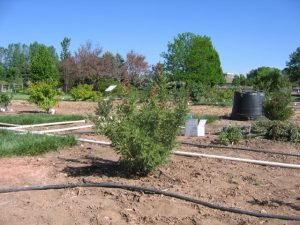
Figure 3: Selected shrubs and turf were planted in plots receiving different levels of irrigation.
In the lysimeter component of the study, both the redosier dogwood and Annabelle hydrangea demonstrated that the more water provided, the better they grow. Treatments began on these two species in 2009 and Figure 5 is a representative photo of both species in each of the three treatments coming out of dormancy. As the plants were breaking dormancy in 2010, the plants receiving 100% ET came out of dormancy more quickly than any of their counterparts in the other treatments. In fact, all of the redosier dogwood replications in the 25% died back to the ground and broke dormancy by starting all of its new growth from the base of the plant. This result leads to the conclusion that if these two shrub species go into dormancy in a stressed state, the plants will come out of dormancy more slowly the following season.
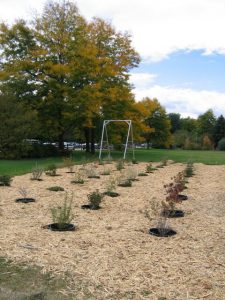
Figure 4: Site of lysimeter study with equipment to lift plants.
The watering amounts for the lysimeter plants not only affected the speed at which both plants broke dormancy, but it also affected their growth habits as well. The more water given to both potted redosier dogwoods and Annabelle hydrangeas resulted in larger plants. As irrigation amounts increased the height, width, and end of season entire above ground plant biomass also increased. Interestingly, end of season sample leaf area and sample leaf fresh/dry weights showed no significant differences among treatments for either species. However, as a result of the plants having a similar relationship with overall size and water use, data collected during dry down periods (periods where the plants were not watered and purposefully stressed to monitor the result) resulted that the plants in the 100% treatment used water at a faster rate than the 50%, and the 50% used water at a faster rate than the 25%. Additionally, by the end of each dry down period, in general, the 100% redosier dogwoods had greater pressure chamber readings (more stressed) than their counterparts in the 25%, and the 100% hydrangeas were equally stressed to the hydrangeas in the 25%. Since the plants increased in size as watering amounts increased, more water was needed to maintain those larger plant sizes. Both species in each
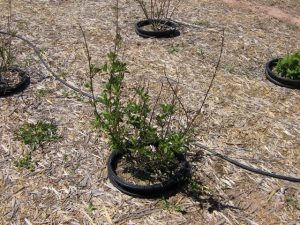
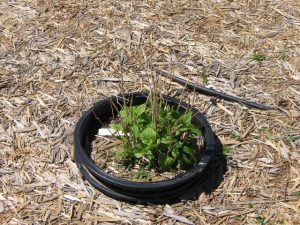
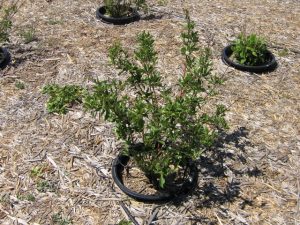
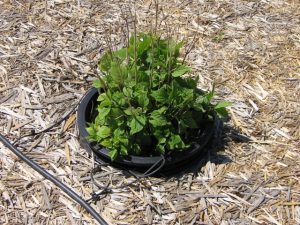
Fig. 5 Lysimeter Cornus (left) and Hydrangea (right) emerging from dormancy at different irrigation regimes.
The infield study resulted that the more water given to dogwoods, ninebarks, and willows may affect some plant characteristics, but after two years of establishment, these three species appeared acceptable for landscape use with little to no additional water during normal precipitation years. Hydrangeas planted in the ground get larger with more water, and as they get larger their demand for water also increases. However, hydrangeas may be able to survive a short period with no water and rebound when water becomes more available. In the lysimeter study the potted dogwoods and hydrangeas displayed that they adjusted their growing habits to account for the water amounts provided to them. If more water is available, the plants will come out of dormancy at a faster rate and more seasonal growth will result.
Thank you to the following companies and organizations for contributing plant materials and monetary funds that have helped to make this study possible:
Alameda Wholesale Nursery Colorado Nursery Research & Education Foundation (CNREF)
Arbor Valley Nursery Colorado Water Institute (CWI)
Fort Collins Wholesale Nursery Colorado WaterWise Council (CWWC)
James Nursery Garden Centers of Colorado
Turf Master Sod GreenCo Foundation
